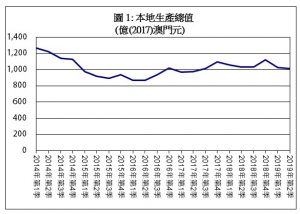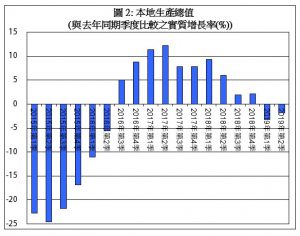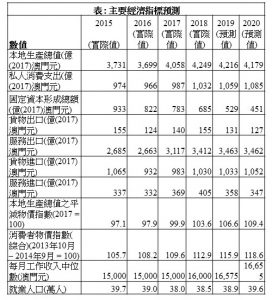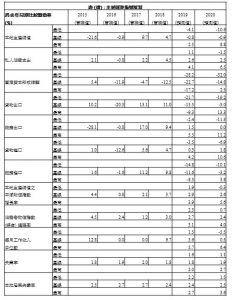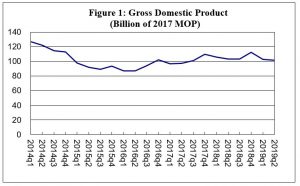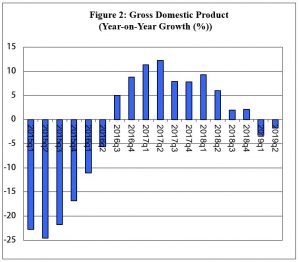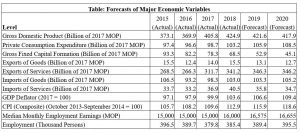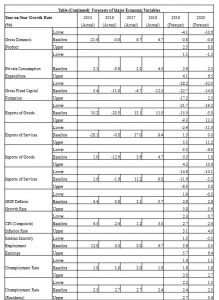The Department of Economics under the University of Macau (UM) Faculty of Social Sciences and UM’s Centre for Macau Studies released the Macroeconomic Forecast for Macao 2019-2020 today (18 September). Macao’s economy was strong in the first half of 2018. The growth subdued rapidly in the second half amid the slowdown in mainland China. It continued to deteriorate in the first half of 2019. The year-on-year growth rates were -3.2% in the first quarter and -1.8% in the second quarter of 2019. (Figure 1 and 2).
The negative effects of trade friction with the United States, structural adjustments, and the depreciation of RMB on China’s economy have deepened in the past few months. The consequences on Macao’s economy have gone beyond our expectations. As a result, we have revised our forecasts downward on GDP growth from the last release.
- With the slowdown in China’s economic growth, Chinese visitors’ spending in Macao, in particular on gaming activities, has weakened. The exports of services accounted for 82.6 billion MOP, a meager year-on-year increase of 0.8% in the second quarter of 2019. Meanwhile, the exports of services in gaming, the largest portion of the exports of services, accounted for 56.1 billion MOP, a year-on-year decrease of 0.8%.
- In the second quarter of 2019, the nominal gross gaming revenue was 73.4 billion MOP, down 0.5% year-on-year and down 3.7% quarter-on-quarter. Revenue from the VIP baccarat accounted for MOP 34.6 billion, decreasing by 15.6% year-on-year and decreasing by 7.0% quarter-on-quarter.
- In July 2019, the total number of visitor arrivals was 3.53 million, up 16.3% year-on-year. The number of visitors from mainland China reached 2.57 million, up 18.5% year-on-year. The number of visitors from Hong Kong reached 0.63 million, up 16.4% year-on-year.
- Exports of goods declined drastically in the second quarter of 2019, down 24.4% year-on-year to MOP 2.8 billion.
- For the second quarter of 2019, the imports of goods declined by 0.8% year-on-year to MOP 24.3 billion. Amid the declining demand for gaming services, imports of services decreased by 13.7% year-on-year to MOP 8.6 billion.
- Within the imports of goods, consumer goods increased by 8.4% year-on-year in the second quarter of 2019 amid a steady growth in consumer spending. Meanwhile, raw materials and semi-manufactures dropped by 8.3% year-on-year. Capital goods decreased by 26.2% year-on-year amid the decline in investment.
- With stable earnings, Macao residents’ spending grew modestly. Private consumption expenditure accounted for MOP 26.4 billion, up 2.2% year-on-year in the second quarter of 2019. The household final consumption expenditure in domestic market and the expenditure abroad increased by 2.2% and 4.0% year-on-year respectively.
- Private gross fixed capital formation continued to decline amid the finishing of major hotels and casinos construction. It decreased by 19.3% year-on-year in the second quarter of 2019 to MOP 11.2 billion. Meanwhile, government gross fixed capital formation declined substantially by 49.7% year-on-year. As a result, total gross fixed capital formation decreased by 25.0% to MOP 12.8 billion. Private construction investment declined by 25.1% and private equipment investment grew by 9.1% year-on-year respectively.
- Real estate transaction recovered in the second quarter of 2019. The total number of resident units purchased and sold was 2,725, accounting for 16.9 billion MOP, up 97.6% and 103.2% quarter-to-quarter, respectively. 275 residential units were sold for over MOP 10 million. 1,764 units were sold between MOP 4 million and MOP 10 million. 510 units were sold between MOP 2 million and MOP 4 million. 176 units were sold for MOP 2 million or less. As regards to the floor area of residential units, 1,091 units (40% of the total) had an area between 50 and 99.9 square meters. The average transaction price of the residential units went up by 7.5% quarter-to-quarter to MOP 110,263 per square meter. The average transaction price of the residential units with an area between 50 to 99.9 square meters registered an increase of 3.6% quarter-to-quarter to MOP 101,810 per square meter respectively.
- Inflation was steady amid slower demand from residents. The Composite Consumer Price Index on July 2019 rose by 2.6% year-on-year. For the two largest components of the Composite Consumer Price Index, namely food and non-alcoholic beverages, as well as housing and fuel, their year-on-year growth rates were 3.6% and 1.9%, respectively (Figure 16). For the aggregate economy, in tandem with the consumer price, the GDP deflator increased by 2.4% year-on-year in the second quarter of 2019.
- Labour market continued to be tight. Unemployment rate for the second quarter of 2019 was 1.7%, same as the first quarter of 2019. Excluding the non-resident workers, the unemployment rate for residents was 2.3%, same as the first quarter of 2019.
- The total employment and employment for residents were 387.2 thousand and 282.3 thousand in the second quarter of 2019, up 0.5% and down 0.7% year-on-year, respectively. Analysed by industry, employment in wholesales & retails was 39.8 thousand, down 11.8% year-on-year. Employment in hotels & restaurants was 55.8 thousand, down 0.9% year-on-year. Employment in construction was 29.5 thousand, down 8.1% year-on-year. Employment in the gaming industry was 87.1 thousand, up 2.4% year-on-year.
- Median monthly employment earnings went up with 1.9% year-on-year to 16,300 MOP in the second quarter of 2019. For the gaming sector, which accounted for the largest share of the employed population, median monthly employment earnings were 20,000 MOP, same as the second quarter of 2018. The median monthly employment earnings for the other major industries such as wholesales & retails were about 14,000 MOP, same as the second quarter of 2018 while the median monthly employment earnings for hotels & restaurants were MOP 12,000, up 7.1% year-on-year.
Source: Centre for Macau Studies
Media Contact Information: Communications Office, University of Macau
Albee Lei Tel:(853) 88228004Kelvin U Tel:(853) 88224322Email:prs.media@um.edu.moUM Website:www.um.edu.mo


